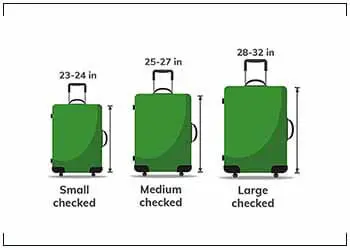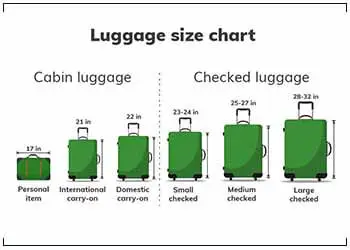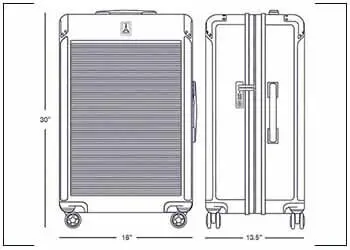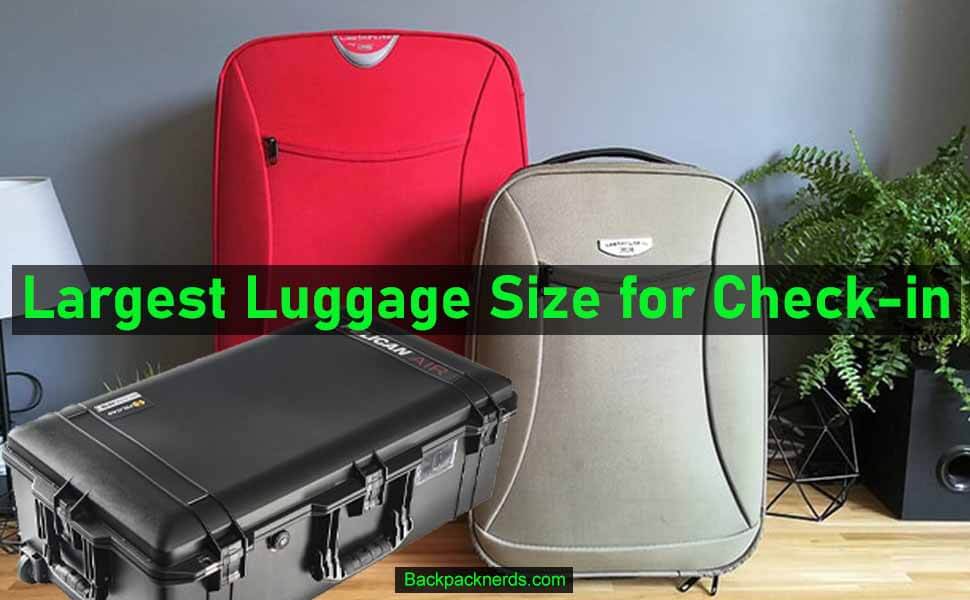The biggest question that travelers frequently ask when they check in at an airport is: “What size luggage can I bring?” It’s a good question because it can have a big impact on your overall experience. And the answer is: “It depends.” In this post, we’re going to take a look at the largest luggage size for check-in that most airlines allow for check-in, and we’ll go over how you can use that information to make the most of your luggage and maximize your check-in experience. In this case, knowing the luggage size guide properly can be helpful.
When it comes to packing for a trip, the last thing you want to do is to overpack. If you’re planning a vacation, you’ll need to pack a lot of things, so you’ll definitely want to keep your luggage under control. There’s no need to pack the entire world into a suitcase. The most important thing to remember is that you should always travel with the bare essentials. You don’t need a lot of stuff when you’re on vacation. Always keep in mind, the largest luggage size for check-in may compensate for some additional charges. So what are the best luggage sizes for checking in?
So choosing the best luggage for your journey can save you money and make you hassle-free. A wrong suitcase would be a burden for you. In this guide, we will try to tell you about the different sizes of bags, restrictions, and others so that you can easily understand what size luggage would be great for you while you are on a vacation.
Intrigued By FAQ?
In most cases, while people are using air travel they may face problems with their luggage if they don’t know the right information about the Air Company. There are some important questions and answers on the largest luggage size for check-in they try to find out. You won’t be wondering hearing that the most frequently asked questions we get from travelers on how to choose the right luggage size are:
- What is the biggest suitcase size can I carry on?
- Which luggage size is right for a weekend or a 3-day trip?
- What are the size and weight limits for checked baggage?
- How many carry-on bags can I bring?
- How much fits in medium- or large-size checked bags?
- Are size limits different internationally or for different airlines?
- Is there a baggage fee for certain bags and not for others?
These questions are generally intriguing to people. However, don’t worry. We are going to learn all of these questions and answers so that you can be well aware of all of them. Moreover, we will help you choose the right luggage and style for you providing the right answers here.
Checked Baggage

Checked-in baggage is all baggage that has been checked in at check-in and will be transported to your final destination with the rest of your bags.
After reaching the airport, you need to check in at the check-in counter. If you are carrying bigger luggage, in that case, you have to hand it over to baggage handlers.
The bags will then be transferred to baggage handling, and they will be loaded into the cargo hold of the airplane.
Once you arrive at the destination airport, you’ll have to pick up your checked baggage from the luggage conveyor belts.
However, you don’t have to use only suitcases to check bags at the airport. You can also use other kinds of baggage such as roller bags, backpack bags, and duffel bags.
Besides, you can use large backpacks, duffel bags, totes, musical instruments in their cases, large trunks, and other oversized items.
Anyways, you’ll want to make sure that you go through all of your categories and check off any of the items that are listed in the “specialty items” section.
Luggage Size Chart

It would be very easy for you to understand if you see the infographic. We will differentiate luggage into two categories; Cabin luggage and Checked luggage. Cabin luggage will be categorized into 3 sizes. The Checked luggage is also categorized into 3 sizes as well. You can see and identify seeing the length of them. Since we are discussing here the largest luggage size for check-in, you can emphasize the checked luggage sizes.
Knowing the policies of the Air company is important because if you don’t know them well, you can fall into problems. This is why you are recommended to go through their websites. However, we will try to understand the size of the luggage, capacity, and the fees if it is oversized.
Now, let’s see it through a table.
| Luggage Size | Size (Longest End) | Capacity | Fees |
| Personal item | Under 17 inches | Essentials | Always free |
| International carry-on | 18-20 inches | 5-14 days | 0-50$ |
| Domestic carry-on | 21-22 inches | 7-14 days | 0-50$ |
| Small checked luggage | 23-24 inches | 2-3 weeks | 20-100$ |
| Medium checked luggage | 25-27 inches | 2-4 weeks | 20-100$ |
| Large checked luggage | 28-32 inches | 3-4 weeks | 20-100$ |
Checked Baggage Size and Weight Limits

Most U.S. domestic airlines publish the maximum allowed total dimensions for checked baggage as a single dimension. It is 62 linear inches in total. You may know International airlines have different policies and they may vary slightly from each other. However, it is true that the 62-inch rule is the most common standard worldwide. Yes, you can travel with the largest luggage size for check-in but you need to pay extra fees for it. This is why reading carefully the policies of the airline you are using can avoid such unexpected situations. The standard dimensions are mostly 62 linear inches in length, 24.5 cubic inches in width, and 16 cubic inches in height.
However, as mentioned earlier, bags larger than 62 linear inches can still fly, but the airlines often charge an additional fee. Calculate the size of your checked-in luggage using the same formula used for your carry-on, and then add the number of bags you have to arrive at the overall dimensions.
A heavier bag means the bag will take longer to pack and a lighter bag will make it easier to pack.
First, you must decide on the size of the checked bags you’re going to bring.
The weight of your checked bag is important. The standard weight limit for checked baggage on domestic flights is 50 pounds per bag.
The big budget airlines, like Allegiant, and Spirit limit the baggage allowance to 40 pounds. And while other carriers such as Norwegian Air and Korean Air are generous enough to allow whopping you a 70-pound allowance per checked bag.
Tips for Buying Check-in Luggage
A checked bag should be made from durable material, but a large carry-on is the most durable. A durable, large handbag is important for any traveler, but it’s especially important for someone who has a lot to carry around.
For example, the Travelpro luggage is engineered for resilience and backed by dependability warranties.
It’s not a good idea to buy a suitcase that weighs more than the maximum allowance because there will be less room in the overhead bin.
| Length of the Trip | TYPICAL CONTENTS | TYPE OF LUGGAGE |
| 1- 2 Days | · 1-3 outfits & sleepwear · Small toiletry bag · Pair of shoes · Essential accessories · Essential devices | · Travel Totes · Weekenders/Duffels · Larger Backpacks · Small Carry-on Spinners & Rollaboard® Bags · Rolling Underseat Carry-ons · Bi-fold/Carry-on Garment Bags |
| 3-5 Days | · 5-9 outfits & sleepwear · Toiletry bag · Pair of shoes · Essential accessories · Electronics | · Weekenders/Duffels · Carry-on Spinners & Rollaboard Bags · Rolling Carry-on Garment Bags |
| 4-7 Days | · 7-14 outfits & sleepwear · Toiletries · 1-3 pairs of shoes · Accessories · Electronics | · Carry-on and Check-in Spinners · Trunks · Rollaboard® Bags · Rolling Carry-on & Check-in Garment Bags |
| Week-long trips and longer | · 10 or more outfits & sleepwear · Toiletries · 3 or more pairs of shoes · Accessories · Electronics | · Medium and Large Check-in Spinners · Trunks & Rollaboard® Bags · Rolling & Check-in Garment Bags · More than one piece of luggage |
What’s the Largest Luggage Size for Check-In?
If you’re looking for checked suitcases that are smaller than 62 linear inches, look for cases of 25, 26, or 27 inches checked luggage. So, a 25, 26, or 27-inch checked suitcase will always fit into an airplane overhead bin, regardless of how much you pack. A larger checked suitcase needs to be below 62 inches in terms of length, width, and depth to avoid being oversize.
However, in some cases, 28 or even 29-inch options can be considered as not oversized, but remember, most of them are oversized, and some come with wheels and handles.
When traveling, don’t forget your small luggage! This bag is just what you need to make sure your luggage won’t be the biggest one on the luggage carousel.
If you have an eCommerce business and are looking for a checked suitcase, the best option is the Samsonite Omni PC Hardside Spinner Set Checked Suitcase. It’s durable and easy to use (there’s a TSA-compliant lock,) yet comes at a reasonably affordable price.
Besides, Pelican Air 1615 Cases are a really good option for maximizing the total amount of packing space.
They can be expensive, but if you buy them from a retailer who understands size restrictions, you will end up with a pair that fits properly and is guaranteed to last for a long time.
Pelican cases are normally used by crews who need to protect their film, sporting, or other equipment when they are on the move.
What Are the Size and Weight Restrictions for Checked Luggage?
Most airlines will allow passengers to take one or two checked bags within 62 linear inches. If you’re over 50-70 pounds, you may need to check a bag with additional charges. Baggage handlers may be restricted from accepting oversized baggage because these limits are set by airline regulators.
Remember, Bags that are out of the allowed limits will not be checked. The airport stores will allow you to check the bag without having to pay an extra fee.
If your bags are exceeding the maximum weight limits, there are other ways to get them to the next level.
You can still take your oversized or overweight bags to the airplane but you’ll have to pay an additional fee.
This fee can be very expensive, though. It can range from $100-300 per bag.
Each airline has a set of rules about what kinds of bags are accepted for check-in. The more expensive airlines allow more bags for free, with sensible size and weight restrictions.
Airlines like Southwest Airlines (LUV) will only allow you to carry a small number of items, so be prepared.
It’s best to check with the airline before you book your flight to avoid paying additional fees.
Tip: If you want to maximize the size of your checked baggage, you should buy one that’s about 62 linear inches. For most travelers, the best option is the Travelpro Bold 28-Inch full-size carry-on suitcase. It’s 58.5 inches or 62 linear inches of luggage. That puts it on the short side, but it’s easy to pack and unpack. Some other options you may consider are the Samsonite Freeform 24-Inch checked suitcase, which is 61 linear inches, and the Pelican Air 1615 checked case, which is exactly 62 linear inches in size.
Is 28, 29, 30, 31, or 32-Inch Luggage Generally Considered Oversized?
Most people don’t really know about all the available kinds of luggage, and the ones over the 62-linear inch checked luggage limit.
Generally, all 32-inch, 31-inch, 30-inch, 29-inch, and 28-inch checked luggage is considered oversized, or over the 62-inch limit.
At the first glance, a few suitcases seem too small. However, they are usually below the 62-inch limit. They generally range between 60 and 62 inches.
Most manufacturers have not included the wheels and handle in the measurements for most of their products.
Before getting a large suitcase, make sure to check the size requirements. You’ll also want to consider the handle options and overall dimensions.
Can You Bring Oversized or Overweight Checked Luggage?
It doesn’t matter if the item is under or over 62 inches long or 70 pounds, most airlines let you bring it on board anyway. There are certain restrictions and fees that apply to this service. If you wish to check your luggage, please contact your airline directly.
However, you will have to pay the oversized or overweight luggage fees, which can get rather pricey.
This luggage will be labeled oversized or overweight, so it will require extra handling. It’s the best way to make sure that you don’t get hurt.
To avoid overstaying your welcome at the airport, know the size and weight limits for your flight.
For example, for American Airlines, it’s 100 lbs. for overweight luggage and 126 linear inches for oversized luggage.
They will not let you take any products that you bring in with you, and if you do, they will charge you.
However, there are some items that are treated differently than normal checked luggage, such as Bikes, Sporting goods, and equipment, Musical instruments, Mobility aids (wheelchairs), Assistive devices (travel oxygen, walkers, crutches, etc.), Items for babies and young children (strollers, infant car seat).
The free mobility aids, assistive devices, strollers, and luggage allowed for free with overweight and oversize luggage will most likely be either permitted or the fees will be small. Most airlines will either allow you to carry the bag of your choice, or they’ll waive the fee for oversized or overweight baggage. This includes bikes, musical instruments, sporting goods, strollers, wheelchairs, and scooters.
You’ll need to inquire each airline individually about them. You can check the websites of every airline to see what the advantages are for their passengers.
If you’re bringing special equipment that’s expensive or fragile, such as a microscope, consider getting a Pelican case, which is a safe option for protecting expensive gear. They are well-known luggage brands.
What Are the Fees for Oversized and Overweight Checked Luggage?
The fees for overweight luggage range from 100$ to 300$. It all depends on the airline and your luggage.
For instance, American Airlines has the following baggage fees:
They charge 100$ for any bags that are between 50-70 lbs.; 200$ for 70-100 lbs. luggage on flights in the US, South America, Canada, Mexico, Caribbean, and Puerto Rico, and 450$ for 70-100 lbs. luggage on flights to China, Japan, South Korea, and New Zealand.
The difference in baggage fees is similar to the weight of the overweight fees. Most airlines charge anywhere from $100 to $200 for each additional bag you have.
For example, on American Airlines, the fare for a round-trip flight to Miami from Chicago varies between $150 and $200, depending on the flight route.
Final Words
Checked luggage is an essential part of your travels. When shopping for a new suitcase, it’s really important to know which size to buy. If you have a large purse or bag, you should look for a carry-on suitcase, which is usually smaller in size.
If you have already learned something about the largest luggage size for check-in, always get a suitcase under 62 linear inches with four wheels and include the handle and wheel sizes.
Remember, Most 32, 31, 30-inch, and about half of the 28-inch bags will be over this limit. That is why you must find luggage that are 25, 26, and 27-inch suitcases that are just one or two inches below 62 linear inches. So if you buy these kinds of suitcases, you can easily avoid such unexpected situations by paying an extra charge for your luggage.
Read More Articles –
- Best Range Backpacks
- Best Travel Laptop Backpacks
- Best Durable Backpacks
- Best Cheap Backpacks
- Best Osprey backpacks
- Best laptop backpacks for men
- Best waterproof backpacks
- Anti-theft backpacks
- Best camera backpacks
- Best stylish backpacks for college girls
- Solar backpacks

